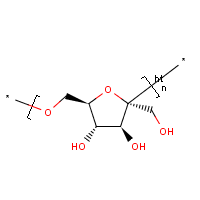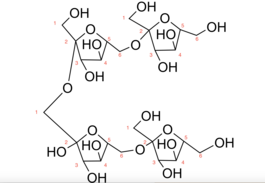Levan polysaccharide

| |
| Names | |
|---|---|
| Other names
Polyfructose
| |
| Identifiers | |
| ChEBI | |
| ChemSpider | |
Except where otherwise noted, data are given for materials in their standard state (at 25 °C [77 °F], 100 kPa).
| |


Levan is a naturally occurring fructan present in many plants and microorganisms.[1] This polymer is made up of fructose, a monosaccharide sugar, connected by 2,6 beta glycosidic linkages. Levan can have both branched and linear structures of relatively low molecular weight.[2] Branched levan forms a very small, sphere-like structure[3] with basal chains 9 units long. The 2,1 branching allows methyl ethers to form and create a spherical shape. The ends of levan also tend to contain a glucosyl residue.[4] Branched levan tends to be more stable than linear polysaccharides.[5] However, the amount of branching and length of polymerization tends to vary among different species.[4] The shortest levan is 6-kestose, a chain of two fructose molecules and a terminal glucose molecule.
Discovery
Levan was first discovered through research on
Production
Levan is synthesized in
Levans are produced by microbes during colonization of a food
Properties
The beta 2,6 linkages of levan allow for it to be soluble in both water and oil; however, the water temperature varies the degree of solubility.[9] Levan also is insoluble in many organic solvents such as methanol, ethanol, and isopropanol.[4] The branching of levan allows it to have a high tensile and cohesive strength, while the hydroxyl groups contribute to adhesion with other molecules.[4] The intrinsic viscosity n, a measure of the substance effect on viscosity of a solution, tends to be very low for levan.[4] This allows levan to be utilized in a pharmaceutical setting.
Real world implications
Many industries such as
Food
In the food industry, levan is incorporated due to its
Cosmetics
Levan can be used for
Medicine
Levan has shown uses for burned tissue,
See also
References
- PMID 25624035, retrieved 2020-05-10
- ISSN 1542-6238.
- ISSN 0144-8617.
- ^ PMID 25662693.
- ^ PMID 27178733.
- ISSN 0365-9496.
- PMID 22672649.
- S2CID 132210454.
- PMC 3747740.
- ^ "Montana Polysaccharides Corp". www.polysaccharides.us. Retrieved 2019-05-15.
- PMID 11518326.
- PMID 12753971.
- ISSN 1300-3070.
- ISBN 9783319967998
- PMID 17158064.
- PMID 33820887.
